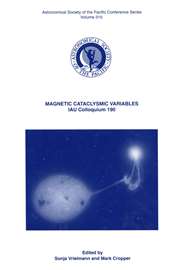No CrossRef data available.
Article contents
The Approach of Improvement to Stellar Coordinate
Published online by Cambridge University Press: 12 April 2016
Abstract
This article presents a new method for observing minor planets. The observation is operated with a photo–electronic imaging devise CCD and a lower latitude meridian circle.
The CCD is mainly used except it is during the favourable opposition of the minor planet when the meridian circle is mainly used in this method. The method can improve precision of observation of planetary position and enlarge scope of observation of planetary orbit. Therefore, the measured precision of zero point of stellar coordinate could be increased. The key of succeeding is that more precise result is got using the CCD.
The experiment in this article indicates that this method is a good way:While a minor planet and calibration stars locate in the same image of the CCD, the measured precisions of the minor plant are
σα = ±0″.03, σ´ ±0″.035;
While the minor planet and calibration stars are located in different images of the CCD, the precisions are
σα = ±0″.06, σδ = ±0″.08.
Information
- Type
- Part 2. Poster Papers
- Information
- Copyright
- Copyright © United States Naval Observatory 1991

